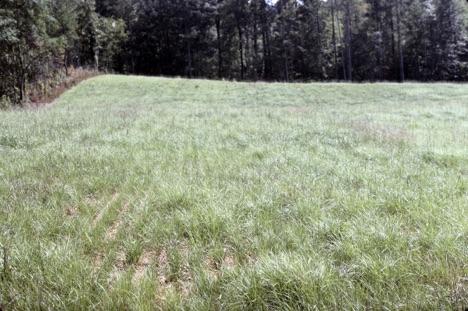
It has been known for centuries that crop rotation is a highly desirable agronomic practice, even if the rotation involves only row crops. Benefits that can result from this practice include: (1) interruption of the life cycles of diseases, harmful insects, and nematodes; (2) more efficient control of weeds as well as reduced weed seed production; and (3) when a legume is used in the rotation, the provision of biologically fixed nitrogen for a succeeding crop in the rotation.
When a perennial forage crop is included in a long-term rotation, the benefits to row crops that follow the forage crop are even greater than occur from merely alternating row crops. In such a situation there will usually be a higher earthworm population, more favorable soil microorganism populations, and increased organic matter in the soil, the results of which are improved soil tilth and better water infiltration. The forage crop can be used for pasture or hay during the time it is being grown, plus wildlife populations are favored when forage crop availability is increased.
In many parts of the nation alfalfa is the most logical forage crop to grow in rotation with row crops. Alfalfa is a high value crop, it is deep rooted and drought tolerant, and it can fix a great deal of nitrogen that is subsequently available to the following crop. Alfalfa can be grown on good land in the Deep South, but because of inappropriate soils or other factors, on many Southern farms it is not a good fit.
For most producers who want to rotate row crops with a perennial forage crop in this region, the best option in many cases is to use bahiagrass. This warm season perennial grass is widely adapted and drought tolerant. It performs and persists well under a wide range of management regimes, and on many soils and sites. Bahiagrass is a sod forming grass that protects the land well from wind and water erosion, thus reducing contamination of surface water by particulate matter and farm chemicals.
In addition to the crop rotation benefits mentioned earlier, bahiagrass develops a substantial root system, which is important for several reasons. It helps alleviate compaction that often results from use of heavy equipment in row crop agriculture. Root channels created by the grass facilitate deeper rooting of annual row crops planted behind it, thus making them less susceptible to drought. Also, bahiagrass is a non-host for some nematodes that damage row crops, including root-knot nematodes that are of particular importance in many areas.
Recent work in north Florida by University of Florida researchers showed that a four-year rotation that featured two years of bahiagrass followed by one year each of peanuts and cotton resulted in significantly better row crop yields than the traditional peanut-cotton rotation. For years, ‘Pensacola’ and ‘Argentine’ were the only bahiagrass varieties of which seed was readily available, but several new varieties are especially useful in crop rotations.
Recently there has been increased enthusiasm for including bahiagrass in crop rotations. Economic considerations, together with increased emphasis on sustainability and environmental concerns by the general public and the government are part of the reason. Weather phenomena that can impact one enterprise much more severely than others are also helping foster this interest. The point is that crop rotation, especially a long-term rotation involving forage crops clearly offers many advantages.
__________________
Foraging Ahead is a column presented by Ragan & Massey and written by Dr. Don Ball, Professor Emeritus at Auburn University. Dr. Ball is one of the authors of the popular book “Southern Forages,” which can be found via a computer search that uses the words, “Southern Forages, The Fertilizer Institute
